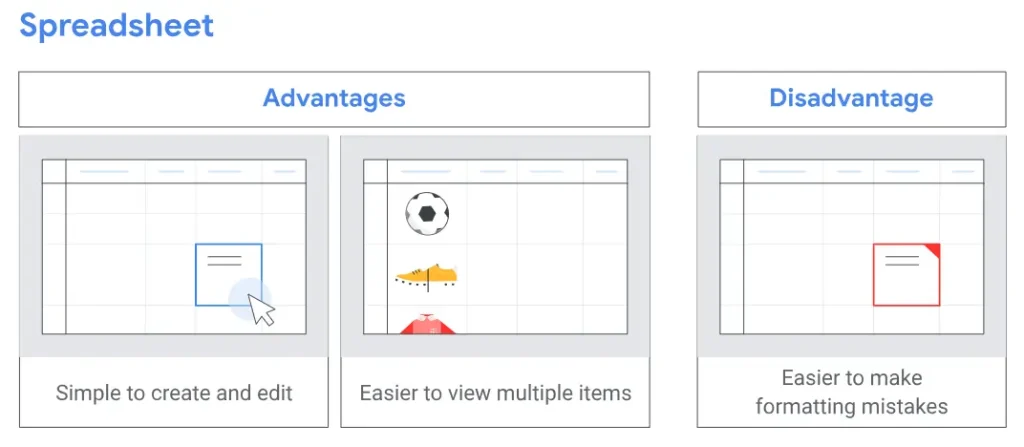When you search for a product on Google—say “Nike running shoes”—and see a neat row of product images, prices, and store names at the top of your search results, that’s powered by something called a Google Shopping Feed.
For e-commerce businesses, this feed is like the magic bridge that connects your product data with Google. It makes sure your items appear in Google Shopping results and Product Listing Ads (PLAs) with the right details, images, and pricing.
But here’s the thing, just having a feed isn’t enough. The way you set it up and maintain it can make a huge difference in your product visibility, click-through rate (CTR), and ultimately, your sales.
In this article, we’ll break down what a Google Shopping Feed actually is, the different types, key attributes you need to know, and the best practices to make it work harder for you.
What is a Google Shopping Feed?
A Google Shopping Feed is essentially a structured file (often in formats like .xml, .txt, or Google Sheets) that contains all the important details about your products. This includes product titles, descriptions, prices, availability, images, and more.

Think of it as a digital “product catalog” that you hand over to Google. The platform then uses this information to display your products in relevant shopping searches and Google Ads campaigns.
Here’s how it works in practice:
- You prepare your feed with accurate, high-quality product data.
- You upload it to your Google Merchant Center.
- Google reviews and processes the feed.
- Your products are eligible to appear in Shopping ads and free listings whenever someone searches for something relevant.
Without a properly optimized feed, your products may not even appear—or worse, they could show up with incorrect details, hurting your conversions.
Differences Between Google Feed, Product Feed, and Google Shopping Feed
These terms get thrown around a lot, and while they’re related, they’re not exactly the same. Let’s clear the air:
- Google Feed
This is a broad term that simply refers to any type of data feed sent to a Google platform. It could be for Google Shopping, Google Ads dynamic remarketing, or other purposes. - Product Feed
This is a more general e-commerce term. A product feed can be used not just for Google, but for platforms like Facebook, Instagram, or Amazon. It’s essentially a file containing structured product data for any channel. - Google Shopping Feed
This is a specific type of product feed tailored to Google Shopping’s requirements. It contains all the attributes Google needs to display your products in Shopping ads and listings.
In short:
- All Google Shopping Feeds are product feeds.
- Not all product feeds are Google Shopping Feeds.
If you mix up these terms, you might end up preparing the wrong file format or missing key attributes that Google specifically requires—costing you impressions, clicks, and potential sales.
Google Shopping Feed Attributes

Your Google Shopping Feed isn’t just a random list of products, it’s built on attributes, which are specific data points that tell Google everything it needs to know about your items.
Think of attributes as the “building blocks” of your feed. The more accurate and complete they are, the better Google can match your products to the right searches and audiences.
Here are the core attributes you should never overlook:
- ID – A unique identifier for each product. This stays consistent even if you update other details.
- Title – The product name. Make it descriptive, include key keywords, but keep it natural for human readers.
- Description – A short but informative text about the product. Focus on benefits and unique features.
- Link – The landing page URL where shoppers can buy the product.
- Image link – The main product image. High-quality, clear, and on a white background often works best.
- Availability – Whether the product is in stock, out of stock, or available for preorder.
- Price – Your selling price, including currency. Make sure it matches your website exactly.
- Brand – The brand name, especially important for branded searches.
- GTIN / MPN – Product identifiers like Global Trade Item Number or Manufacturer Part Number (for better matching in Google’s database).
- Condition – Whether it’s new, refurbished, or used.
There are also optional attributes that can give you an edge, like sale price, shipping details, size, color, gender, and age group—especially useful for apparel and accessories.
Pro Tip: Inaccurate or missing attributes can lead to disapprovals in Google Merchant Center, killing your chances of showing up in Shopping results. Always double-check your data before uploading.
5 Google Shopping Feed Types and How to Use Them
Not all Google Shopping Feeds are created equal. Depending on your store size, how often your inventory changes, and how you manage your catalog, you can choose from different feed types. Here are the main ones:
1. Primary Feed
This is your main product feed in Google Merchant Center. It contains all the core product data that Google uses for Shopping ads and listings. Every store needs one primary feed—it’s your foundation.
2. Supplemental Feed
Think of this as an add-on to your primary feed. It doesn’t work on its own but is great for adding or updating specific attributes without replacing your entire feed. For example, if you need to add sale prices or seasonal promotions quickly, supplemental feeds are a lifesaver.
3. Automated Feed (via Website Crawl)
If you don’t want to manually create a file, Google can crawl your website to pull product data automatically. This is convenient but not always perfect—if your site’s structure is messy, you might end up with incomplete or inaccurate data.
4. API Feed (Content API)
Ideal for large stores with frequently changing inventory. The Content API lets your store’s backend send product updates directly to Google Merchant Center in real time. Perfect for dynamic pricing or flash sales.
5. Google Sheets Feed
For smaller stores or those just starting out, you can use Google Sheets to create and manage your feed. It’s simple, and updates are easy—but it can become time-consuming as your product catalog grows.
Choosing the right feed type comes down to your business size and workflow:
- Small store with a stable catalog? Google Sheets or a basic primary feed is enough.
- Large store with frequent updates? Go with the Content API plus supplemental feeds for flexibility.
How to Optimize Google Shopping Feed
Creating a Google Shopping Feed is one thing—optimizing it is what makes the real difference between just “showing up” and actually getting clicks and conversions.
Here’s how to make your feed work harder for you:
1. Write Product Titles That Sell
Include important keywords naturally in your titles so Google can match your products with relevant searches. For example, instead of “Running Shoes,” use “Nike Men’s Air Zoom Pegasus 39 Running Shoes.”
2. Use High-Quality Images
Clear, high-resolution images with a clean background perform better. Lifestyle shots can also boost engagement in certain categories.
3. Keep Pricing and Availability Accurate
Nothing kills trust faster than a shopper clicking your ad only to find the price is wrong or the item is out of stock. Regular updates are a must—especially if you run sales.
4. Leverage Optional Attributes
Go beyond the basics. Add details like color, size, gender, and material to improve matching and visibility.
5. Refresh Your Feed Regularly
Google rewards fresh and accurate data. If your feed gets outdated, you risk losing impressions or having your products disapproved.
6.Segment Your Products for Better Campaigns
Structure your feed so you can group products by category, margin, or performance. This helps you improve targeting and allocate your budget where it matters most.
7. Track and Adjust Based on Performance
Use your campaign data to spot which products are driving clicks but not sales. You can then adjust pricing, improve descriptions, or run remarketing campaigns to bring back potential buyers.
Pro Tip: A well-optimized feed can dramatically improve your CTR, making every dollar of ad spend go further.
Conclusion
Your Google Shopping Feed is more than just a spreadsheet. When it’s set up and optimized correctly, it ensures your products appear in front of the right audience, at the right time, with the right information.
But managing a feed can be time-consuming, especially if you’re juggling dozens (or hundreds) of products. That’s where expert help makes all the difference.
At Ostenpowers, our Google Ads consultants from Sydney will make sure your feed is primed for success. From structuring your product data to fine-tuning your campaigns for higher clicks and conversions, we handle it all so you can focus on growing your business.
If you’re ready to take your Google Shopping performance to the next level, let’s make it happen. Get in touch today and see what a perfectly optimized feed can do for your sales.









